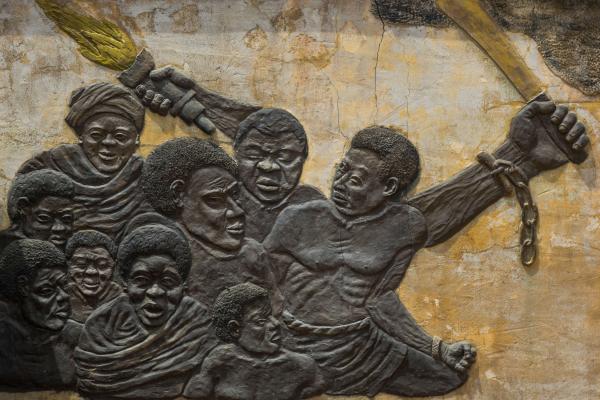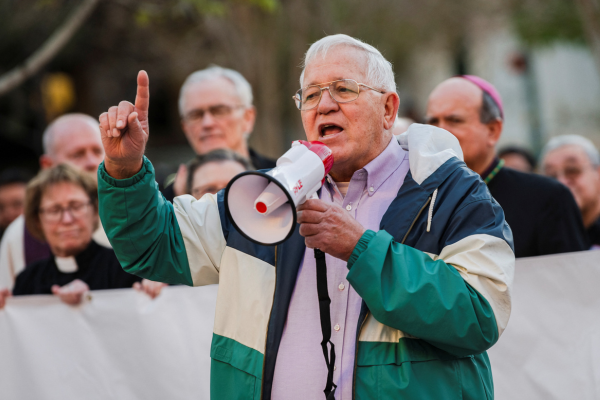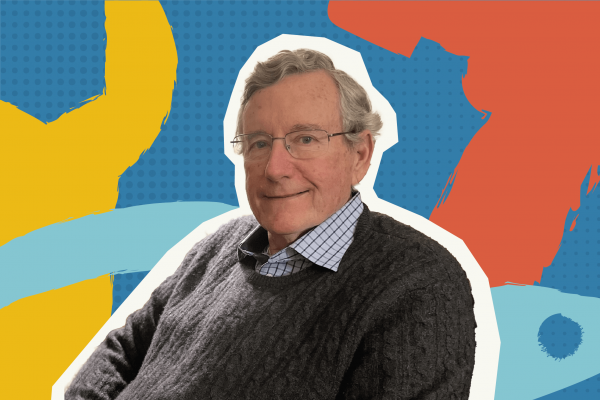This interview is part of The Reconstruct, a weekly newsletter from Sojourners. In a world where so much needs to change, Mitchell Atencio and Josiah R. Daniels interview people who have faith in a new future and are working toward repair. Subscribe here.
Was Robert E. Lee, the infamous confederate general who went to war to defend slaveocracy in the South, a Christian? The answer to this question may seem obvious: Yes. Lee was an Episcopalian who was called a “humble, earnest Christian” by a minister who was his contemporary. But some Christians may recoil at the idea that someone they see as clearly at odds with Jesus’ call to “release the captives,” would be considered a Christian.
For abolitionist and statesman Frederick Douglass, the answer was to draw a distinction between the “pure, peaceable, and impartial Christianity of Christ,” and the “corrupt, slaveholding, women-whipping, cradle-plundering, partial and hypocritical Christianity of this land.”
“Indeed, I can see no reason, but the most deceitful one, for calling the religion of this land Christianity,” Douglass wrote.
For Douglass, it was a sham to refer to the dominant U.S. religion as “Christianity” — a feeling that holds true for many today. The sentiment is heard in phrases like: “Donald Trump is not a Christian” or “Christian nationalism is a heresy.” These statements attempt to draw the lines of “true Christianity” and define clearly, essentially, who is in and who is out.
It’s no accident that the question of “true” faith is wrapped in politics. As theologian David Congdon writes in his new book, Who Is a True Christian?, the call to “Make America Great Again” has often coincided with a call to “Make Christianity Great Again.”
Congdon sees these efforts as largely misplaced. There is a better way, he believes, for Christians to define and redefine “Christian” faith without relying on authoritarianism or an essential “orthodoxy” that transcends space and time.
In our conversation, we explore the concept of “polydoxy,” the political implications of “true Christianity,” and Douglass’s distinction. If it’s not wise to cast bounds and declare that someone “is not Christian,” then what is? How do we positively push and define Christian community toward more liberative practices and standards?
This interview has been edited for length and clarity.
What does Frederick Douglass’s differentiation between the “Christianity of this land” and the “Christianity of Christ” mean in reference to this project?
The project is certainly trying to find a way to both affirm what Douglass wants to say, but also advocate for a different way of saying it. I think Douglass’s formulation, if [it was] said by somebody today, we would have to be a little more critical of the way it’s phrased because — besides the fact that Christ was not a Christian — the “Christianity of Christ” is not straightforwardly good, it’s not straightforwardly a positive narrative reality for the world. It’s a complex, historically contingent, culturally constructed institution that has produced a number of effects in the world, but not all of which are beneficial.
A straightforwardly good “Christianity of Christ” and bad “Christianity of this land” is not historically plausible.
The book is trying to reshape how we phrase that. I want to affirm that Douglass is speaking in a prescriptive mode. He is trying to prescribe a certain kind of Christianity, saying, “This is how we ought to live.” And he is advocating a certain way of being in the world — a way of being a faithful Christian that is antithetical to enslavement. That’s certainly what I want.
At the same time, I want to steer us away from trying to say, “This is what Christianity is.” [And steer us away from saying] it is essentially, eternally the case that Christianity is antithetical to enslavement. Because we know that’s not the case.
And while we should obviously criticize the way Christianity has been formed in the United States, it’s by no means an aberration from history. The U.S. is not some lone, corrupt version of Christianity that other countries are pure and innocent of.
We have to really be careful about some of these essentialist claims that end up simplifying a very complex historical reality.
It seems like this book is trying to communicate beyond a divide between historians, who descriptively define Christianity as “things Christians do” and theologians who prescriptively define Christianity as “a set of essential beliefs or practices that transcend space and time.” Those theologians are often interested in defining a specific set of Christian practices/beliefs that have been passed down to us, in continuity, from the beginning. But the book is also skeptical of a definition of “continuity” as a theological concept. Why is continuity such an appealing idea for faith communities?
The scholar Judith Lieu, who I quote in the book, talks about how continuity is necessary for identity, and that’s really what this debate is about. People feel that their identity as “Christian” is threatened, or that it’s at stake in these debates. We want continuity because it’s the source of the stability of what it means to be a Christian. At least that’s the widespread assumption: We have tradition, we have orthodoxy, we have these concepts to set boundaries because we want to know that we are inside those boundaries and the things that we disagree with are outside those boundaries — which generates a lot of tension and conflict over who gets to determine what remains in continuity with the past and what doesn’t.
I certainly affirm and recognize why these issues can become so heated and so contentious. At the same time, I’m hoping to push people toward an understanding of Christian identity that no longer rests on continuity.
What would it rest on then, if not continuity? Is it scripture or the person of Jesus or so on?
In my formulation, it rests, in some sense, on transgression itself: the constant boundary-crossing, the ongoing task of reconstructing and rethinking our identity as Christians. That very process itself is what I suggest ought to be understood as essential to Christianity. In some ways I’m de-essentializing the essence. I’m shifting the concept of essence from something stable and continuous to something unstable and discontinuous. That is to say that each person or each local community is empowered to explore new conceptions of their identity as Christian, and that process, that quest for discovery and reconstruction, is itself important.
In other words, we’re not trying to find what is “true Christianity,” but rather in the finding itself, Christianity is being manifested.
In the book, you talk about polydoxy; what is that?
Polydoxy is a format, a version of communal identity that doesn’t rest on orthodoxy and doesn’t rely on the authoritarian policing of boundaries. It’s a non-authoritarian identification of religious communal identity. Where orthodoxy requires a magisterial authority to set the boundaries for who is in and who is out, polydoxy instead argues for religious self-authority.
In polydoxy, religious autonomy is the core constitutive factor in a religious community.
What are some good examples of polydoxy?
A number of Quaker communities have been a good example of this. [Jewish rabbi and theologian] Alvin J. Reines also argues that there are often de facto polydox communities. They may not, in theory, have any polydoxy on the books. They might be orthodox communities on the books, but the way they practice their faith is certainly polydox.
I was part of a progressive, Episcopal community in the Chicago area, which was absolutely a polydoxy in the way it was practiced. Beyond the fact that it was a very diverse community, it was religiously inclusive and didn’t adhere to any sort of doctrinal or theological boundaries that had to be adhered to — even at the level of belief. Belief was not a boundary you had to demonstrate in order to be part of that community. I appreciated the effort by that priest to really create a sense of communal participation and mission that was rooted in consent and the desire of the local people to participate in the work that they were doing.
One of the inspirations for this project was the fact that I teach Reformed theology for the University of Dubuque Theological Seminary. Even though I’m not Reformed, I teach Reformed theology in a way that is polydox in practice. I appreciate the PC(USA) because it has a book of confessions that, while there are certain sort of doctrinal theological themes, the fact that they have a book of multiple confessions — which don’t all agree, which are in dialogue with each other and demonstrate different theological values and beliefs — means their theological boundaries are open-ended. Certainly, some PC(USA) churches tend toward a more authoritarian orthodoxy, but the Book of Confessions models a kind of limited polydoxy that recognizes a range of theological positions that are acceptable under the larger umbrella of the denomination.
How does polydoxy make Christian community more difficult? If a community isn’t formed around a boundary — ethnic, cultural, doctrinal, etc. — how does a community itself have action in the world? To have organized action you have to have some sense of boundaries, right?
The question is a legitimate one in the sense that we do want communities to have some sort of identity, some sort of stability that we can [identify] and that can be a mobilizing basis for communal action and for gathering together and shared commitments and values. I think that’s all good. Local communities, however large, should continue to engage in that process of establishing what they’re about, what they value, and engaging in the world from that perspective. That’s fine.
What I want to steer away from and encourage people to avoid is the notion that the boundary between a community and what’s outside of it has to be policed in terms of truth and falsity. Throughout history, in order to protect their community, communities have cast themselves as being the bearers of the flame of truth, and those on the outside as having not heard the truth or abandoned the truth or being enthralled to sin or something. That produces this constant effort to renegotiate, solidify, and reinforce the barriers between “us” and “them.”
What polydoxy helps to conceptualize is a way of thinking about communal participation that’s rooted in consent and engagement, and the freedom to violate those boundaries [and] move away from a community. So, we’re not constantly trying to protect and keep people in, but we allow the boundaries to be one of mutual consent and mutual affirmation. If communities change, if people change, then that’s fine. That’s okay. And we should embrace and affirm that process of moving away and moving out of different local communities.
Of course, that poses a problem to institutional stability. I’m quite okay with that loss. A huge amount of the sources of our religious strife are due to institutions trying to protect their property, money, population, and cultural and political power. Boundary reinforcement happens to ensure those resources remain intact. And we need to let that go.
I find what you’re writing about here to be very — small d — democratic, but I want to talk about what that looks like practically. If someone finds themselves on the outside of that communal consent, what happens? Is there a way to harmonize keeping communities as a place of mutual consent while caring for those who disagree?
Yes. Fair warning here: This book is certainly not an attempt to provide a map for how this should be implemented. So, I want to acknowledge my limitations on this score. There’s more to be written — a whole other book probably — on what this might look like in practice.
Reines points out that the fundamental norm for polydoxy is religious self-determination, religious autonomy. That’s the only version of orthodoxy that he insists on keeping. I affirm that, and the implication is that norms and values shouldn’t be erected in such a way that people are forced to leave a community for anything other than a violation of religious autonomy. Now, I do suggest that communities should be able to establish certain values and a shared mission that they care about.
I felt like a lot of the book was a challenge toward people interested in prescriptive, theological definitions of Christianity. But in the introduction of the book, you’re talking about bridging the prescriptivist theologians to the descriptivist historians and journalists, who are talking about Christianity in a historical, objective way. I can see very clearly how polydoxy would change how theologians talk about “who is a true Christian,” but I was having a harder time seeing it changing how a historian or journalist would talk about “who is a true Christian.”
I’m not offering some sort of radical change for them. I think they should continue to do descriptive work. I’m not trying to offer anything to the historians and the sociologists and the journalists — they’re already doing great work. What I’m arguing is for self-described “believing Christians” to internalize the challenge of those who do descriptive work and find a prescriptive or normative conception of Christianity that is able to do justice to the descriptive side.
What are the political implications here? Where do these theological questions of orthodoxy become political ones?
It is, in some ways, always political. The book is really about how Christianity changes in modernity. The modern period [the philosophical period from roughly the 17th-20th centuries] forces Christians to redefine their boundaries and redefine who they are as Christians. I set out to understand how the renegotiations that become necessary in modernity are bound up with the political renegotiations happening at the larger national level. These dual quests — the quest for true Christianity and the quest for true Americanism — are happening simultaneously. [The question is] to what extent the norms of Christianity are going to have implications at the political level.
Then, of course, [Christians in that period] are trying to protect certain social norms and cultural norms — like enslavement and other issues — that certain Christians didn’t want to let go of. And so, they have to redefine their boundaries of Christianity to accommodate the practices, norms, and institutions that they are already engaged in. There’s a lot of justifying their own social conditions and their power.
What I talk about especially is the way that this quest for defining Christianity — especially in the 20th century, when there’s a strong push toward “historic Christianity” — is implicated in politics.
[The project of] “making Christianity great again,” is what I argue is central to the modern project of Christian essentialism and Christian identity formation. That project sets up and leads toward a larger discourse around “making America great again.” Those two things are feeding each other. I don’t think there’s a clear causal line from one to the other, but I use the viral metaphor to say that there’s a larger “discourse coalition” being formed around the idea of laying hold of some historic formation/idea and constructing society or one’s church or one’s identity around that idea of the past.
That past doesn’t exist. It has never existed — whether the American version or the Christian version — but that’s part of the point. It’s an imagination, a construction, that provides a political and social ideal that motivates boundary-making and the exclusionary, authoritarian practices that go along with it.
Let’s say you’re a Christian on the Left who is used to saying, “Donald Trump isn’t Christian,” or “Christian nationalism is a heresy.” What should you say instead?
One simple response is that we should say something along the lines of, “The Christian community should not be hospitable to somebody like Donald Trump.” It’s a statement of ought or should. In other words, it’s not saying that Christianity is not capable of accommodating Donald Trump, right? Obviously, it is. It’s saying that it shouldn’t be.
We should be, we ought to be, a community in which somebody like Donald Trump doesn’t have the kind of power and sway that he currently does. So, it’s framing it in a prescriptive way as a goal we ought to strive toward, rather than as a declarative, descriptive statement of what always and eternally is.
Got something to say about what you're reading? We value your feedback!







